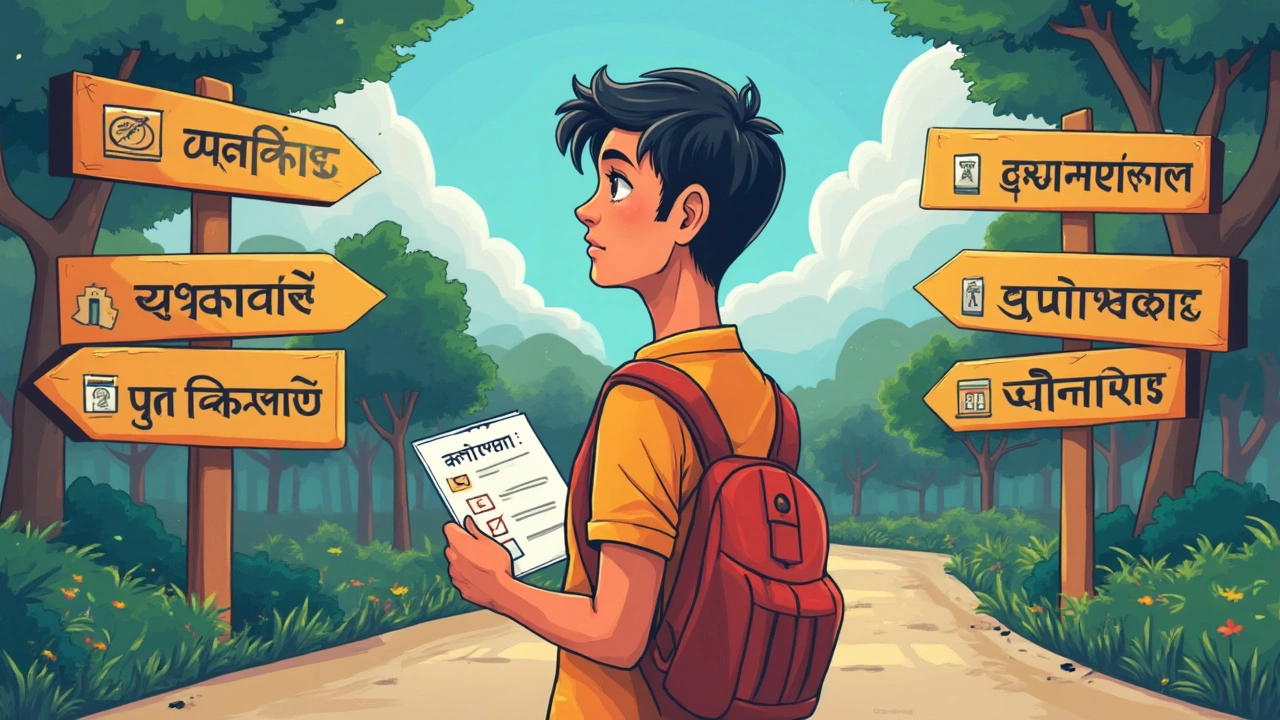If you’re dreaming of free college—or even just lower tuition—your first stop is probably a scholarship exam. Sounds intimidating? It’s actually a game changer: millions sit for these tests every year, hoping for a shot at big financial relief. But with so many exams out there, picking the right one is almost its own challenge.
Here's the crazy part: more than $100 million in scholarships go unclaimed each year because students either think they're not qualified or don’t know where to start. Missing out just because of confusion? That’s painful. A lot of students ask which exam is ‘best’—but the answer isn’t one-size-fits-all. It depends on your background, goals, and where you want to study. Let’s clear up the clutter and focus on what actually matters when choosing and prepping for a scholarship exam.
- Why Scholarship Exams Matter More Than You Think
- Most Popular Scholarship Exams and Who They’re For
- Decoding Exam Eligibility and Formats
- What Scholarship Exams Really Test (and What They Don’t)
- Smart Ways to Choose the Right Exam for You
- Extra Tips to Nail Your Scholarship Exam Journey
Why Scholarship Exams Matter More Than You Think
Too many people see scholarship exams as just another test, but they often open doors most folks never even hear about. Here’s the deal: most major universities, both in your country and abroad, use exam results to hand out serious funding. It's not just about marks—it’s about getting noticed by decision-makers who control real money.
The reach is huge. In India, for example, more than 1.5 million students register for top scholarship tests every year. The U.S., on the other hand, gives out around $7 billion in merit-based scholarships annually, a ton of it tied directly to exam scores like the PSAT, SAT, and ACT. These aren’t niche programs—they’re the fast track to reducing or totally ditching college debt.
| Country | Estimated Students Taking Scholarship Exams (Yearly) | Total Scholarship Amount (USD) |
|---|---|---|
| USA | Millions | $7 billion+ |
| India | 1.5 million+ | $500 million+ |
Passing these exams often does more than get you money. Some schools and organizations use your results to give out internships, mentorships, or direct job offers. Even if you don’t win a scholarship, a high score can boost your confidence and beef up your CV. Plus, many of these tests check skills beyond textbooks—like communication or leadership—so a good score can make you stand out in the real world.
Here's a tip: some scholarship exams are hardly advertised and have almost zero competition. Less people means better odds. If you know where to look and prepare seriously, you can grab funding others miss—not because they couldn’t win, but because they didn’t even try. That's why these exams matter way more than most students realize.
Most Popular Scholarship Exams and Who They’re For
Seriously, there’s no shortage of scholarship exams out there, but a few always pop up as the big players, especially if you’re aiming for major universities or looking for the easiest route to grab financial aid. Each exam has its own target crowd, so it pays to know which one matches your plans.
- SAT/ACT: If you're thinking about colleges in the US, these are the go-to tests. Loads of universities use SAT or ACT scores not just for admission but also for giving out scholarships. You don’t even have to score in the top one percent—many schools offer awards for decent scores that are above average.
- PSAT/NMSQT: Mainly for high school juniors in the US, the PSAT doubles as the qualifying test for the National Merit Scholarship. Even being a semifinalist can open up thousands in scholarship money.
- GRE/GMAT: Headed to grad school? Many business and engineering schools worldwide use these test scores for scholarship decisions. High scores make you stand out for merit-based funding.
- Olympiad Exams (like Math, Science, or Computer): If you love a subject, scoring well in national or international olympiads doesn’t just get you medals—many countries and universities award scholarships to toppers.
- Country-Specific Exams: For example, the JEE Main/Advanced and KVPY (in India) or Gaokao (in China)—these aren’t just for getting into top colleges but also offer huge scholarship opportunities if you crush the scores.
Want to see how much is actually at stake? Check this out:
| Exam | Top Prize | Who Should Take It |
|---|---|---|
| SAT/ACT | Up to $50,000/year in some cases | US college-bound students |
| PSAT/NMSQT | $2,500 (National Merit) | US high school juniors |
| JEE Main/Adv | Full tuition + stipends | Engineering/Science students in India |
| Olympiads | Varies (up to $10,000+) | Subject whiz kids |
Here’s the catch: each of these scholarship exams targets slightly different students. For some, like the SAT or GRE, scores can be reused for multiple applications and scholarships. For others, like the Olympiads or JEE, high ranks mean straight-up cash and perks. It's all about matching your strengths with the exam most likely to unlock the aid you want.
Decoding Exam Eligibility and Formats
Alright, so before you even pick one of these scholarship exams, you need to know if you’re allowed to sit for it, and what taking it will actually look like. Each test has its own rules about who can apply. Some are only open to high school seniors, others are just for college students, and a few ask for specific grades, subject streams, or family income.
Check out how eligibility usually breaks down:
- Age/Grade: Stuff like the SAT, ACT, and many national-level scholarship tests (like India’s NTSE or Olympiads) are usually open to students between 15 to 18 years old. Others, like the GRE or GATE, target those finishing college.
- Marks/Academic Performance: Plenty of scholarships demand a minimum GPA. For example, you might need at least a 75% average for government scholarships in India, or a 3.0 GPA in the US.
- Income or Special Category: Some scholarships are for students from specific backgrounds—think first-generation collegegoers, those from low-income families, or people from under-represented communities.
- Course/Subject Specific: STEM scholarships often need science or math backgrounds, while arts scholarships want creative work samples.
Now for the test format itself. There’s no one way these exams get set. Some are all about multiple-choice questions (think SAT or PSAT), some throw in essays (the National Merit Scholarship in the US loves a good short answer), and others have a mix. Olympiads and entrance-style scholarships may toss in practical or subject-specific problems.
Here’s a simple table showing what you might face in some popular scholarship exams:
| Exam | Eligibility | Format |
|---|---|---|
| SAT | High school students, all nationalities | MCQs, Math & English |
| National Merit Scholarship (US) | US high school juniors | MCQs, Essay |
| NTSE (India) | Indian 10th graders | MCQs, Mental Ability & Scholastic Aptitude |
| GATE (India) | Graduates in engineering/science | MCQs, Subject Specific |
And here’s something people forget: rules can change every year. Always check the official website for the latest on eligibility and format. If you’re not sure, reach out to the exam board. Don’t waste time prepping for an exam you can’t even register for. That’s a rookie move you can avoid.

What Scholarship Exams Really Test (and What They Don’t)
Let’s get real about what scholarship exams actually look for. Most people think you have to be a genius, but that’s not true. These tests mostly want to see if you can handle academic basics and a little extra challenge. If you’ve ever tackled the SAT, ACT, or even India’s NTSE or JEE Mains, you know the drill.
Here’s the breakdown of what nearly every major scholarship exam checks:
- Math and Problem Solving: Not rocket science (okay, unless it’s for engineering), but expect questions on logic, algebra, and word problems. They test speed and accuracy way more than tricky theory.
- Language Skills: English is the main one for international exams like SAT, but in India, some let you choose regional languages. Reading comprehension, grammar, and basic essay writing pop up a lot.
- General Knowledge & Current Affairs: Some big scholarship exams—think KVPY or Olympiads—add this to see if you’re aware of what’s happening beyond textbooks. They don’t get too weird with it, but expect basic politics, science, and world events in the mix.
- Reasoning: Logical reasoning puzzles and pattern questions show up to test how you think, not just what you memorized.
Now for what they usually don’t test (huge relief):
- Your personal life story or hobbies. Unless it’s an essay-based or interview round, your soccer awards or late-night Minecraft skills won’t matter here.
- Practical vocational stuff. You might be a whiz with a soldering iron, but these exams rarely touch trade skills—unless it’s a specific technical scholarship.
- Super advanced degree subjects. Don’t stress about PhD-level content—scholarship exams aim right at your current or just-above-grade abilities.
Check this out for some context on what sections might look like. Here’s a quick comparison for three popular scholarship exams:
| Exam | Main Areas Tested | Anything Unusual? |
|---|---|---|
| SAT (College Board) | Math, Reading, Writing | Essay is now optional |
| NTSE (India) | Mental Ability, Science, Social Science | Some states add regional questions |
| KVPY (India Science stream) | Math, Physics, Chemistry, Biology | Checks concepts, not cramming |
Don’t overthink what you need. These exams want you to show solid basics, quick thinking, and an ability to stick with tricky problems. If you understand what’s on the table, you can plan prep instead of panicking or wasting time on stuff you’ll never see on the test.
Smart Ways to Choose the Right Exam for You
Picking the right scholarship exam can make or break your chances of snagging that sweet financial aid. You don’t want to waste time or cash on the wrong test. Here’s how to stay smart about your next move:
- Know your strengths. STEM fan? Aim for exams like KVPY or NTSE in India, or the National Merit Scholarship Qualifying Test in the US. More of a humanities buff? Some essay-based scholarships, like the J.N. Tata Endowment, look for your writing chops. Match your skills to the test requirements.
- Check eligibility up front. Don’t fall in love with an exam only to get kicked out for missing a deadline or being in the wrong grade. The CBSE UDAAN, for example, only takes girl students in Class XI. The SAT is open to everyone, but some scholarships ask for a specific nationality or high school year.
- Consider the rewards. Some exams offer huge scholarships, but come with heavy competition. For example, the National Talent Search Exam (India) helps with school fees and even college—but it’s brutally competitive, with only about 1,000 winners out of 1.6 million candidates. On the other hand, smaller regional scholarships might be easier to win and can stack up.
- Check the format and prep time. If you kill it at multiple-choice, go for standardized tests like the PSAT or CET. Not a fan of time pressure? Some scholarships take home assignments or portfolios.
- Location matters. Trying for a scholarship abroad? Focus on exams like the SAT, ACT, or IELTS. For local aid, stick to state or national level selectors.
- Be real about your schedule. If you’re already slammed with board exams or activities, don’t add an all-consuming test to your plate. Some scholarships accept results from regular board or entrance exams—no extra work needed.
Here’s a quick look at popular exams and what they target:
| Exam Name | Best For | Eligibility |
|---|---|---|
| NTSE | School Students (Class 10) | Indian Nationals, Class 10 |
| SAT | College-bound, studying abroad | Open, mostly high school juniors/seniors |
| KVPY | Science Lovers | Indian Students, Class 11/12/First Year UG Science |
| National Merit (PSAT/NMSQT) | US High Schoolers | Class 11, US citizens |
Here’s the main thing: don’t just chase the fanciest or most hyped scholarship exams. Target the ones where your strengths line up and the odds are fair. That way, you’re not just playing the game—you're playing to win real financial aid.
Extra Tips to Nail Your Scholarship Exam Journey
So, you’re set on grabbing that scholarship exam spot. There’s more to it than just knowing the syllabus. You need to play smart. Here’s what works in real life, not just in theory:
- Start Early, Stay Consistent. Don’t save everything for the final month. Research from the College Board says students who prep over several weeks score nearly 15% higher than last-minute crammers.
- Know the Scoring Patterns. Some tests (like the SAT or many government scholarship tests) actually penalize for wrong answers. Others just skip ‘em. Double check so you know when to skip and when to take a risk.
- Mock Tests = Hidden Gold. Taking timed mock tests isn’t just for bragging rights. Regular practice (at least one mock per week) helps you spot weak spots and avoid silly mistakes on the main day.
- Focus On Strong Sections First. In multi-section exams, grab easy marks in your strongest areas before sweating the tough stuff. It’s a classic topper move that works for everyone.
- Don’t Ignore the Rules. Read instructions twice. Some scholarship exams will disqualify you for tiny mistakes, like writing your name where you shouldn’t or filling bubbles wrong.
Wondering about your competition? Here’s a quick look at average applicant numbers and award rates for major scholarship exams:
| Exam | Average Applicants (Yearly) | Selection Rate (%) |
|---|---|---|
| NTSE (India) | 900,000+ | 1.25 |
| National Merit (USA) | 1,500,000+ | 3 |
| KVPY (India) | 300,000+ | 2 |
Stats like these show that every mark matters, so don’t slack on the last details. For extra help, join online forums or Telegram groups focused on your target scholarship exam — students swap tips, share recent papers, and sometimes insiders post sample questions straight from last year’s sets.
Finally, keep your documents ready (ID proof, admit card, certificates, whatever’s needed). Every year, hundreds miss their shot because they mess up simple paperwork. A checklist on your wall can honestly save your future self some grief.



